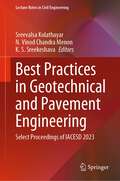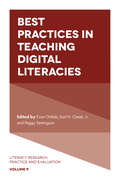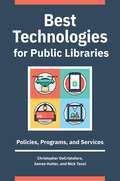- Table View
- List View
Best Practices in Engaging Online Learners Through Active and Experiential Learning Strategies (Best Practices in Online Teaching and Learning)
by Stephanie Smith Budhai Ke'Anna Brown SkipwithBest Practices in Engaging Online Learners Through Active and Experiential Learning Strategies, Second Edition, is a practical guide for all instructors, instructional designers, and online learning administrators designing, developing, teaching, and leading online, hybrid and blended learning courses and programs, who seek to provide supportive, engaging, and interactive learner experiences. This book explores the integration of active and experiential learning approaches and activities including simulations, gamification, social media integration, project-based learning, scenario-based learning, virtual tours, and online micro-credentialing as they relate to the development of authentic skill-building, communication, problem-solving, and critical-thinking skills in learners. New and emerging learning technologies of virtual and augmented reality along with artificial intelligence are included in this updated edition with examples of how instructors can actively use them in online courses to engage learners in experiential experiences. Readers will find guidelines for the development of participatory and peer-learning, competency-based learning, field-based experiences, clinical experiences, and service-learning opportunities in the online classroom. In addition, the authors provide effective learning strategies, discipline-specific examples, templates, and additional resources that align learner engagement with assessment practices and course outcomes.
Best Practices in Engaging Online Learners Through Active and Experiential Learning Strategies (Best Practices in Online Teaching and Learning)
by Stephanie Smith Budhai Ke'Anna Brown SkipwithBest Practices in Engaging Online Learners Through Active and Experiential Learning Strategies, Second Edition, is a practical guide for all instructors, instructional designers, and online learning administrators designing, developing, teaching, and leading online, hybrid and blended learning courses and programs, who seek to provide supportive, engaging, and interactive learner experiences. This book explores the integration of active and experiential learning approaches and activities including simulations, gamification, social media integration, project-based learning, scenario-based learning, virtual tours, and online micro-credentialing as they relate to the development of authentic skill-building, communication, problem-solving, and critical-thinking skills in learners. New and emerging learning technologies of virtual and augmented reality along with artificial intelligence are included in this updated edition with examples of how instructors can actively use them in online courses to engage learners in experiential experiences. Readers will find guidelines for the development of participatory and peer-learning, competency-based learning, field-based experiences, clinical experiences, and service-learning opportunities in the online classroom. In addition, the authors provide effective learning strategies, discipline-specific examples, templates, and additional resources that align learner engagement with assessment practices and course outcomes.
Best Practices in Engaging Online Learners Through Active and Experiential Learning Strategies (Best Practices in Online Teaching and Learning)
by Stephanie Smith Budhai Ke'Anna SkipwithBest Practices in Engaging Online Learners Through Active and Experiential Learning Strategies is a practical guide for all instructors and instructional designers working in online or blended learning environments who want to provide a supportive, engaging, and interactive learner experience. This book explores the integration of active and experiential learning approaches and activities including gamification, social media integration, and project- and scenario-based learning, as they relate to the development of authentic skill-building, communication, problem-solving, and critical-thinking skills in learners. Readers will find guidelines for the development of participatory peer-learning, cooperative education, and service learning opportunities in the online classroom. In addition, the authors provide effective learning strategies, resources, and tools that align learner engagement with course outcomes.
Best Practices in Engaging Online Learners Through Active and Experiential Learning Strategies (Best Practices in Online Teaching and Learning)
by Stephanie Smith Budhai Ke'Anna SkipwithBest Practices in Engaging Online Learners Through Active and Experiential Learning Strategies is a practical guide for all instructors and instructional designers working in online or blended learning environments who want to provide a supportive, engaging, and interactive learner experience. This book explores the integration of active and experiential learning approaches and activities including gamification, social media integration, and project- and scenario-based learning, as they relate to the development of authentic skill-building, communication, problem-solving, and critical-thinking skills in learners. Readers will find guidelines for the development of participatory peer-learning, cooperative education, and service learning opportunities in the online classroom. In addition, the authors provide effective learning strategies, resources, and tools that align learner engagement with course outcomes.
Best Practices in Geotechnical and Pavement Engineering: Select Proceedings of IACESD 2023 (Lecture Notes in Civil Engineering #449)
by Sreevalsa Kolathayar N. Vinod Chandra Menon K. S. SreekeshavaThis book presents select proceedings of the International Conference on Interdisciplinary Approaches in Civil Engineering for Sustainable Development (IACESD 2023). The topics covered include emerging practices in geotechnical engineering and pavement, innovative approaches, and technologies to enhance the durability, sustainability, and performance of infrastructure, geosynthetics, geotechnical monitoring systems, and ground improvement techniques to address soil stability, settlement, and liquefaction issues. This book is useful for researchers and professionals’ geotechnical engineering.
Best Practices in Lean Manufacturing: A Relational Analysis (SpringerBriefs in Applied Sciences and Technology)
by José Roberto Díaz-Reza Jorge Luis García Alcaraz Adrián Salvador Morales GarcíaThis book reports four structural equation models (SEM) for quantifying the relationship between the most important lean manufacturing (LM) practices applied to the manufacturing industry. The SEMs are evaluated using 220 responses to a survey applied to manufacturing companies applying LM principles in the production system and are related to: distribution and maintenance, production process and quality system, supply chain and quality, and an integrator model. The findings identify the most important activities for every LM practices and how they are related. These relationship’ values will help administrators, managers, engineers to focus their efforts on these most important activities, facilitating the decision-making process.
Best Practices in Manufacturing Processes: Experiences from Latin America
by Jorge Luis García Alcaraz Leonardo Rivera Cadavid Rosa Guadalupe González-Ramírez George Leal Jamil Mario Gustavo Chong ChongThis book reports the best practices that companies established in Latin America are implementing in their manufacturing processes in order to generate high quality products and stay in the market. It lists the technologies, production and administrative philosophies that are being implemented, presenting a collection of successful cases of studies from Latin America. The book describes how the tools and techniques are being integrated, modified and combined to create new technical resources for assisting the decision making process for better economic performance in manufacturing companies. The efforts deployed for assisting the transformation of raw materials into products and services are described. The authors explain the main key success factors or drivers for success of each tool, technique or hybrid combination approach applied to solve manufacturing problems.
Best Practices in Teaching Digital Literacies (Literacy Research, Practice and Evaluation #9)
by Evan Ortlieb Earl H. Cheek Jr. Peggy SemingsonThe almost universal reliance upon digital tools for social, academic, and career development will only become more pronounced in the years to come. Teacher education programs remain ill-equipped to adequately prepare educators with the pedagogies needed to foster digital literacies. What is needed is a set of best practices towards teaching digital literacies so that teachers can better meet the emerging needs of their students in today’s classrooms. Where should teachers begin? What are the essentials of digital literacies within K-12 contexts? And how might we reimagine teacher education programs to optimally prepare teachers for working with technologically connected youth, whose literacies are more complex, interconnected, and diverse than ever? This volume provides a practical framework for teacher education programs to develop K-12 students’ digital literacies. It offers a set of best practices in teaching digital literacies that promote access to research-based pedagogies for immediate implementation in classrooms.
Best Practices in Teaching Digital Literacies (Literacy Research, Practice and Evaluation #9)
by Peggy Semingson Earl H. Cheek Jr. Evan OrtliebThe almost universal reliance upon digital tools for social, academic, and career development will only become more pronounced in the years to come. Teacher education programs remain ill-equipped to adequately prepare educators with the pedagogies needed to foster digital literacies. What is needed is a set of best practices towards teaching digital literacies so that teachers can better meet the emerging needs of their students in today’s classrooms. Where should teachers begin? What are the essentials of digital literacies within K-12 contexts? And how might we reimagine teacher education programs to optimally prepare teachers for working with technologically connected youth, whose literacies are more complex, interconnected, and diverse than ever? This volume provides a practical framework for teacher education programs to develop K-12 students’ digital literacies. It offers a set of best practices in teaching digital literacies that promote access to research-based pedagogies for immediate implementation in classrooms.
Best Technologies for Public Libraries: Policies, Programs, and Services
by Christopher DeCristofaro James Hutter Nick TanziEmerging technologies can intimidate with their cost and uncertainty—this book provides flexible options for adopting the most popular ones.Introducing new technologies to your library can be a daunting process; they can be costly, they may be unfamiliar to many staff members, and their success is far from assured. To address these concerns, Best Technologies for Public Libraries accommodates budgets large and small, providing options for both the ambitious and the cost-conscious. Authors Christopher DeCristofaro, James Hutter, and Nick Tanzi provide a resource for staff looking to incorporate a number of emerging technologies into their library and makerspaces. Each chapter explores a new technology, including 3D printing, drones, augmented reality, and virtual reality, covering how the technologies work, the selection process, training, sample programming, best practices, and relevant policy. By describing a variety of program and service ideas across age groups, the book gives readers the ability to first evaluate them within the context of their own organization before incorporating ideas à la carte. This approach helps readers to adopt these new technologies and create policies with uses already in mind.
Best Technologies for Public Libraries: Policies, Programs, and Services
by Christopher DeCristofaro James Hutter Nick TanziEmerging technologies can intimidate with their cost and uncertainty—this book provides flexible options for adopting the most popular ones.Introducing new technologies to your library can be a daunting process; they can be costly, they may be unfamiliar to many staff members, and their success is far from assured. To address these concerns, Best Technologies for Public Libraries accommodates budgets large and small, providing options for both the ambitious and the cost-conscious. Authors Christopher DeCristofaro, James Hutter, and Nick Tanzi provide a resource for staff looking to incorporate a number of emerging technologies into their library and makerspaces. Each chapter explores a new technology, including 3D printing, drones, augmented reality, and virtual reality, covering how the technologies work, the selection process, training, sample programming, best practices, and relevant policy. By describing a variety of program and service ideas across age groups, the book gives readers the ability to first evaluate them within the context of their own organization before incorporating ideas à la carte. This approach helps readers to adopt these new technologies and create policies with uses already in mind.
Best Value in Construction
by John Kelly Roy Morledge Sara WilkinsonAchieving value in construction is now emerging as the main challenge facing the construction team if they are to offer the best service for the client. No longer is the aim simply to keep costs under control. This book from the RICS Foundation analyses how to provide best value by the effective application of leading edge techniques and processes throughout the entire life cycle of buildings, from the business case which underpins their initiation to the achievement of a satisfactory project out-turn. This book is a successor to Quantity Surveying Techniques: New Directions, edited by Peter Brandon and published on behalf of the Royal Institution of Chartered Surveyors by Blackwell. It will be of interest not only to surveyors and construction managers but also to final year undergraduates of construction degrees. '[This book] will make a major contribution to the advancement of the methods by which construction professionals provide a service to their clients' - Professor Peter Brandon
Bestehen bei Kalkstickstoffdüngung Gefahren für die Haustiere?: Inaugural-Dissertation zur Erlangung der Veterinärmedizinischen Doktorwürde der Tierärztlichen Fakultät der Ludwig Maximilians-Universität zu München
by Willi HundhammerDieser Buchtitel ist Teil des Digitalisierungsprojekts Springer Book Archives mit Publikationen, die seit den Anfängen des Verlags von 1842 erschienen sind. Der Verlag stellt mit diesem Archiv Quellen für die historische wie auch die disziplingeschichtliche Forschung zur Verfügung, die jeweils im historischen Kontext betrachtet werden müssen. Dieser Titel erschien in der Zeit vor 1945 und wird daher in seiner zeittypischen politisch-ideologischen Ausrichtung vom Verlag nicht beworben.
Bestimmung der Asche- und Schwefelverteilung bei steinkohlegefeuerten Dreizugkesseln: (pdf) (Forschungsberichte des Landes Nordrhein-Westfalen)
by Peter Wiemer Horst GlinkaBestimmung der mittragenden Breite von längsversteiften Plattenfeldern unter Punktlasten und gleichzeitig vorhandenem homogenem Gegendruck (Forschungsberichte des Landes Nordrhein-Westfalen)
by Erich VollbrechtBestimmung der Schwefelverteilung bei steinkohlegefeuerten Öfen: (pdf) (Forschungsberichte des Landes Nordrhein-Westfalen)
by Dipl.-Ing. Kurt Lenhart Dipl.-Ing. Hanns-M. Trenck Dipl.-Ing. Geo AsimusBestimmung der Sitzposition und Körperhaltung von Zweiradfahrern für charakteristische Zweirad-Fahrerplatzkonfigurationen (Forschungsberichte des Landes Nordrhein-Westfalen #3139)
by Fuad ShibliBestimmung des Automatisierungsgrades der rechnergestützten NC-Programmierung (fir+iaw Forschung für die Praxis #20)
by Volker PfennigDem Anwender der NC-Technik steht heute ein breites Sprektrum rechnergestützter Systeme als Hilfsmittel zur Automatisierung der NC-Programmierung zur Verfügung. Die Vielfalt der angebotenen Systeme mit unterschiedlicher Hard- und Softwareausstattung lassen die Auswahl einer anforderungsgerechten Lösung zur anspruchsvollen Planungsaufgabe werden. Die Problematik der Systemauswahl liegt insbesondere darin, die Automatisierungsbestrebungen soweit voranzutreiben, daß der Quotient aus Systemnutzen und Systemaufwand ein Optimum darstellt. In diesem Buch wird eine Methode zur Bestimmung des Automatisierungsgrades der rechnergestützten NC-Programmierung dargestellt. Die Methode erlaubt es, allgemeingültige Aussagen über den mit dem Einsatz eines rechnergestützten Systems zu realisierenden Automatisierungsgrad der NC-Programmierung abzuleiten. Die Praktikabilität wird anhand einer exemplarischen Anwendung demonstriert.
Bestimmung des Faserabbaues bei Leinen unter besonderer Berücksichtigung der Leinengarnbleiche (Forschungsberichte des Wirtschafts- und Verkehrsministeriums Nordrhein-Westfalen)
by Leo BrandtBestimmung von Entfernungsbildern durch aktive stereoskopische Verfahren (Fortschritte der Robotik)
by Ralph SasseBestimmung von Getriebeverformungen und Flankenrichtungskorrekturen mehrstufiger Zahnradgetriebe (Forschungsberichte des Landes Nordrhein-Westfalen #2687)
by Manfred WeckBestimmung von Leistung und Wirkungsgrad eines Ventilators (Forschungsberichte des Wirtschafts- und Verkehrsministeriums Nordrhein-Westfalen #605)
by Leonhard BommesBestimmungsmethoden Enzyme: für Pharmazie, Lebensmittelchemie, Technik, Biochemie, Biologie, Medizin
by B. StellmachBestücken von Leiterplatten mit Industrierobotern (IPA-IAO - Forschung und Praxis #121)
by Ernst WolfBetalains: Biomolecular Aspects
by Erum Akbar Hussain Zubi Sadiq Muhammad Zia-Ul-HaqThis unique text provides comprehensive coverage of betalains, outlining the specific makeup and uses of this plant. The chapters provide deep insight into the biosynthesis, structures, pharmacokinetics, stability, extraction, health benefits and occurrence in nature of betalains. As the first major reference work to focus specifically on betalains, this book serves as an important reference for any researcher looking for insights into the use of betalains as functional foods, food coloring agents, and nutraceuticals. Betalains: Biomolecular Aspects outlines the chemical structure of betalains, including their occurrence in nature. The utilization of of these plants as natural color in food and beverages is covered in depth, as are the intake and secretion of betalains in the human body. The various factors affecting the stability of betalains are described, including their stability when used in food products. Current health related uses for these plants are outlined, including antioxidant and anti-inflammatory uses. The isolation and purification of these plants, plus analysis techniques, are outlined. In providing extensive coverage of betalains and their uses, this text presents a singular work which is of major value for a wide range of researchers.




















